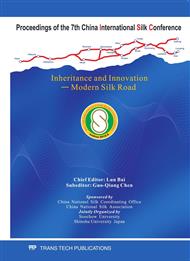p.3
p.8
p.13
p.19
p.25
p.30
p.36
p.41
Application of Pebrine Detection by PCR Infected Bombyx Mori Eggs
Abstract:
With the development of the PCR technology, especially the improvement of its reagent and a method of pebrine detection by PCR in infected Bombyx mori eggs was established.With the 16sRNA gene of Nosema bombycis as target sequence, the results of extraction of genomic DNA from purified microspores showed that 1.3×10-7µg DNA can be extracted from each spore. The sensitivity detection showed the detection limit of Nosema bombycis DNA was 3.25×10-2pg, i.e. 4 spores. (PCR system volume is 25µl). The method of total DNA extraction from pebrine infected silkworm eggs just before hatching was created. The result showed that extracting total DNA from silkworm eggs after the eggs had been treated with 30% KOH met the PCR detection requirements. The result of application study showed the spores in the pebrine infected egg just before hatching can sensitively be found with PCR. The result of a group of eggs just before hatching detection showed that the maximum PCR detection level was of a pebrine infected eggs just before hatching in 300 healthy eggs when the total DNA extraction had been purified with Agarose electrophoresis. The probability of identifying groups of one pebrine spore in infected eggs just before hatching mixed with 100 healthy ones was about 80%.
Info:
Periodical:
Pages:
8-12
Citation:
Online since:
January 2011
Authors:
Price:
Сopyright:
© 2011 Trans Tech Publications Ltd. All Rights Reserved
Share:
Citation:


